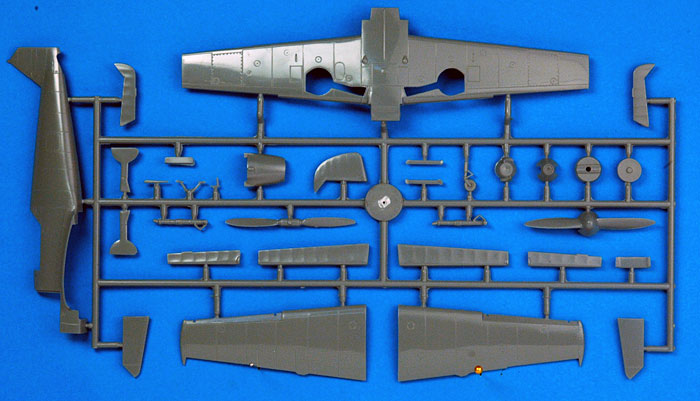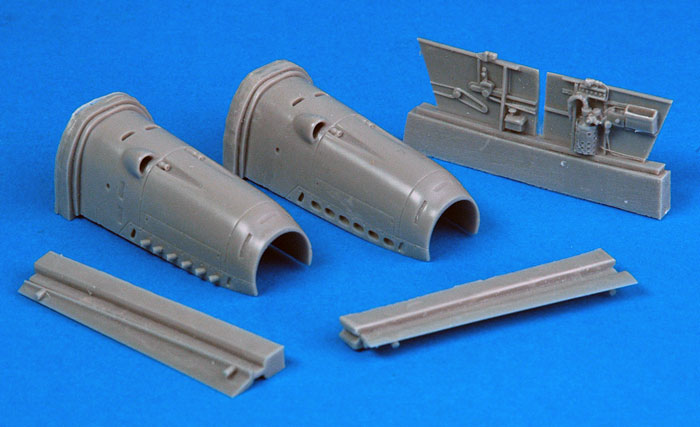|
Messerschmitt Bf 109C/D

Classic Airframes, 1/48
scale
S
u m m a r y
|
| Catalogue Number: |
4125 - Messerschmitt Bf 109C/D |
| Scale: |
1/48 |
| Contents and Media: |
34 parts in grey styrene; 17 parts in grey colored
resin; photo-etched fret; 3 clear injection molded parts; printed clear
acetate sheet (instruments); instructions; decal sheet and
painting guide for four aircraft. |
| Price: |
MSRP
USD$40.00 |
| Review Type: |
FirstLook |
| Advantages: |
Without question the best injection plastic Bf
109C/D in any scale; accurate; excellent surface detail including
crisply recessed panel lines, very high quality plastic moulding;
impressively detailed resin parts; includes plenty of parts options;
separately packed clear, photo-etched and resin parts; thin, three-part
canopy; interesting and varied marking choices. |
| Disadvantages: |
Some modelling experience helpful for preparing
resin parts; hole will have to be drilled for wing machine guns;
Electrical socket and oxygen filler point need to be rescribed further
aft. |
| Recommendation: |
Highly Recommended |
Reviewed by
Brett Green

Classic
Airframes' 1/48 scale Messerschmitt Bf 109 C/D is available online from Squadron
Although modellers have a great selection of
Messerschmitt Bf 109E, F, G and K kits, the situation has been fairly
grim for fans of the early Jumo powered prototypes and early production
models.
Hobbycraft's 1/48 scale kits are widely available
and inexpensive, but they are seriously flawed in terms of accuracy. Problems include too shallow and
misplaced gun slots, incorrectly positioned carburettor intake scoop,
inaccurate panel lines and cooling slots on the cowling, poorly shaped
and poorly detailed radiator intake, very poor Schwartz propeller, short
wing slats, undersized canopy (and one-piece too), cockpit configuration
more typical of a later model and some 109E attributes on the fuselage.
Classic Airframes continues their family of Jumo
109s with the new Messerschmitt Bf 109C/D kit. This kit shares the basic
components with the recent Classic Airframes Bf 109 A, with new parts
included for the major characteristics of these later models.
Classic Airframes' 1/48 scale early Bf 109 kit
comprises 34 parts in grey styrene; 17 parts in grey colored resin; a
photo-etched fret; 3 clear injection molded parts; printed clear acetate
sheet (instruments); instructions; plus a decal sheet and painting guide for
four aircraft.
In common with the Bf 109 A kit, the plastic parts are absolutely first rate.
Moulding quality is excellent, and the highly polished finish does not
reveal any moulding imperfections on the exterior surfaces. This shiny
surface will be especially useful for modellers who plan a bare metal
finish for their Bf 109. Panel lines are crisply recessed, and fabric
control surfaces are quite subtly done. The main difference between the
109 A plastic and this new release is the wings. These are equipped with
the short leading edge slats.

Click
the thumbnails below to view larger images:
The shape of the model looks accurate - a vast improvement over the
old Hobbycraft kits. Specific attributes of the early 109s are well
represented, including the wing root fairing without the reinforcement
strip, long leading edge slats and the location of various hatches and
panels. A plastic Schwartz prop plus a VDM variable pitch unit are both
included, but the Schwarz prop can go straight to your spares box for
this version.
Although there are no locating pins on the main parts, the bottom of
the wing has been reinforced with a long spar. This will add rigidity
and ensure the correct dihedral.
Resin parts are beautifully detailed. The one-piece cowls are
cleverly delivered with the carburetor intake scoop, exhaust panel and
even machine guns cast in place. Two different cowls are offered - one
with the early exhaust ports (basically holes in the cowl), and the
second with the late-style ejector ports. Cleverly, the ejector exhausts
are cast as part of the one-piece resin upper cowl. The position of the gun
troughs, panel lines, exhausts and slots look to be correct.
Other unique attributes of these early Jumo 109s are well represented
too, including a separate radiator intake fairing with fine radiator
face detail cast inside, well-detailed cockpit floor and sidewalls, the
seat,
instrument panel with integrated gunsight, and the standard control
stick. I was impressed with the
rudder pedal assembly too, which even includes cast-on hydraulic lines
behind the pedals.
The remaining resin parts are the wheels featuring nice deep hubs,
short-length leading edge slats and wheel well inserts. A selection of
the parts are presented below:

Some of the parts, including the radiator front, oil cooler, Schwartz
prop, wheel well inserts and
the instrument panel, are cast onto stout blocks so a combination of a
good razor saw and caution will be required when preparing these resin
components.
The photo-etched parts supplements all this nice detail with an
instrument panel, harness, a fuselage face with cooling holes (a really
nice touch), additional radiator face details and two alternate main
gear doors. If the modeller wants to slice off the tail wheel oleo
scissor, a photo-etched replacement is also supplied.
Accuracy is generally very good, with only a couple of nit-picky
issues. The oxygen filler point and electrical socket on the kit's
starboard fuselage are actually in the positions for the 109
prototypes/A/B. These were moved farther aft on the 109C and D. There is
a good illustration of these differences on the "109 in Spain" website
http://www.zi.ku.dk/personal/drnash/model/spain/bf109.html
As long as we are on the subject of minutiae, the wing gun access
hatches are the correct shapes and locations on the upper and lower
wings, but there is no indication for drilling the hole in the leading
edge.
Note that the gun barrels did not protrude from the leading edge.
That only started with the MG-FF cannon fitted to the E-3.
Markings
Four interesting marking options are offered on the instructions - a
night fighter in 71/02/65 based in Norway during 1940, and three
machines finished in the more usual 70/71/65 splinter pattern - Red 9,
-+- of JG 132 in Germany, 1939; and White 2 of 1/JG137 from August 1939.
There are also plenty of very interesting after-market decals
available for these late-Jumo variants if you want a bit more variety.
Classic Airframes has delivered, without question, the best detailed
and most accurate injection moulded Jumo-powered Bf 109 kit available in
any scale.
Granted, this model will need a little more cleanup
and preparation of parts than a long-run release from Tamiya or Hasegawa.
Also, the lack of locating pins will call for extra care and
dry-fitting. In other words, modelling skills are required, but
anyone who has already built a Classic Airframes kit should not have any
trouble coming up with a great result straight from the box.
I have already
built Classic Airframes Bf 109 A kit and, with a little extra
time spent on preparation, it was a real pleasure to work on.
I feel that
Classic Airframes' Messerschmitt Bf 109C/D would be an ideal candidate for a modeller who has a few plastic kits under their belt and would like to
try their first limited run offering.
Highly Recommended to experienced modellers.
Thanks to
Classic Airframes for
the review sample.
Classic Airframes
kits are available worldwide through hobby retailers and from
Squadron.com
Review and Images Copyright © 2006 by
Brett Green
Page Created 14 March, 2006
Last updated 14 March, 2006
Back to HyperScale Main Page
Back to Reviews Page
|
Home | What's
New | Features
| Gallery |
Reviews | Reference
| Forum
| Search